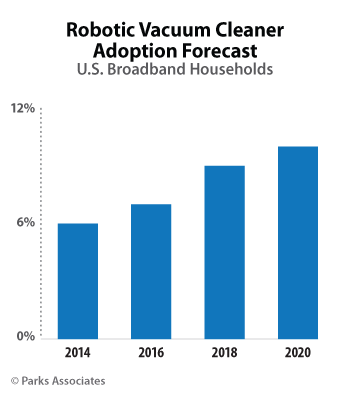The Landscape for Home Robotics
 The prevailing consumer image of robots is one of a personal assistant or butler that can communicate, is mobile, has arms and legs, and performs a multitude of tasks inside, outside, or even away from the home—in other words, a machine that makes the dream of leisure at home a reality. However, in reality, many of today’s robots resemble typical in-home electronic devices and are single-purpose.
The prevailing consumer image of robots is one of a personal assistant or butler that can communicate, is mobile, has arms and legs, and performs a multitude of tasks inside, outside, or even away from the home—in other words, a machine that makes the dream of leisure at home a reality. However, in reality, many of today’s robots resemble typical in-home electronic devices and are single-purpose.
Within the robotics industry, there are multiple definitions of robotics. In general, companies believe robots are autonomous, intelligent, can understand the environment around them, and have the ability to produce an external effect—in essence, a robot perceives, thinks, and acts.
The line between consumer robotics and smart home/automated devices is not always clear. In a sense, a smart dishwasher can be considered a robot, albeit a rudimentary one, because it performs physical work for its owner in an automated way. It can perform tasks—washing and drying dishes—from start to finish on its own when no one is around. While this demonstrates a degree of autonomy, devices such as smart appliances and thermostats are limited in what they can perceive around them, what they can understand, and what actions they can take.
Despite the established growth of robotic floor cleaners and the more recent introduction of consumer robots as educational toys, personal assistants, and lawn mowers, the broad category of home robotics remains nascent. New products in development are highly innovative and bode well for the future; however, today, there are significant challenges to producing robots for the home environment.
Consumer robotics is currently under development in a broad range of university research labs, corporations, private companies, and start-ups. Innovators are developing both functional and emotional robots and, in some cases, robots that are both. The goal of emotional robots is to interact with humans and, perhaps, even bond with them, whereas a functional robot performs a task. The home robotics industry will grow in small steps as technology catches up with developers’ visions and engineers develop the technology solutions required to change those visions into reality.
Parks Associates examines the market for consumer robotics in the industry report Robotics: Changing the Way You Live at Home. Click here for more information.
Further Reading:
- The Connected Consumer: Top Trends in IoT
- Brain Corporation: The Real Driver for the Connected Consumer is Yet to Emerge
- Smart Home Products Market Set to Double by 2017
Next: Will the New Chromecast Audio Kiss the Sky?
Previous: 7% of U.S. broadband households with pay-TV service plan to cancel their pay-TV service
Comments
-
Be the first to leave a comment.
Post a Comment
Have a comment? Login or create an account to start a discussion.


